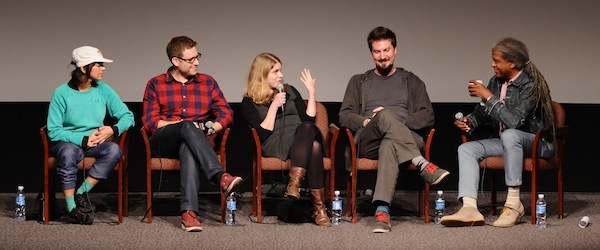A New Wave of Horror: Breakthrough Genre Directors Talk Scary Movies at the Forum

Being a filmmaker is “like being the weirdo in a John Hughes film,” said Ana Lily Amirpour at last month’s Film Independent Film Forum. “You spend your time trying to change yourself to fit in to a bunch of different stuff, and then in the end you realize it’s better to just be the freaky weirdo that you are, and be friends with the people that are into that.”
Amirpour, whose directorial debut A Girl Walks Home Alone at Night hits theaters this Friday, was part of the panel Breakthrough Genre Directors: A New Wave of Horror. Joining her on the panel were Adam Wingard, director of The Guest and You’re Next; Leigh Janiak, whose first feature Honeymoon is available now on VOD; and Spectrevision Co-President and Director of Development Daniel Noah, whose producing credits include Cooties, The Boy and A Girl Walks Home Alone at Night. Film Independent curator Elvis Mitchell moderated.
Mitchell asked what was the first movie that really scared each of them. Amirpour said she watched “a shitload of horror movies” as a child but was quite disturbed by E.T., which she still hates; Wingard said he watched very few scary movies, and the first one he saw in theaters was Scream; Janiak remembered one fateful sixth-grade sleepover where her mother inexplicably permitted Psycho but not Child’s Play; and Noah got a rude awakening as a very small child when he accidentally turned on The Twilight Zone instead of his usual Saturday morning cartoons. “I remember just taking this thing in, and the feeling of disorientation was strangely appealing to me as a little kid,” Noah recalled, “and so this is something that I personally am fascinated by: why are some people drawn to this feeling, and others are repelled by it?”
“I’m of the opinion that every story is a horror film,” Noah said. “Every film is about facing a fear. You can call it that or you can not call it that, but what I believe horror does for people, in a sort of therapeutic or a medicinal way, is it gives us an opportunity to kind of practice facing things that will scare us in an environment that we know is safe, kind of akin to being on a roller coaster.” Amirpour agreed that “what’s scary can be anything,” and Janiak admitted that she didn’t even think of Honeymoon as a horror film until it was selected for the midnight section at SXSW.
The horror label is both a blessing and a curse. There’s always an audience for any movie on Netflix’s horror page, but that audience has strict expectations and hates to be disappointed. “With Honeymoon, people would click on it because it’s a horror movie, and it’s not exactly a horror movie,” Janiak said, “so that expectation is almost like, did you fail as a film? Because we thought we were getting a horror movie, and we didn’t.” Amirpour had a similar experience at genre film festivals: “The hardcore genre crowd at genre festivals? Those people were pissed,” she said of reception for A Girl Walks Home Alone at Night. “They were like, ‘This is boring, arty, hipster shit. I’m not scared. It’s basically, like, Dirty Dancing, or something.’”
“It does feel increasingly to me that there’s the festival experience, and then VOD,” Noah said, “and if there is a theatrical in between that, it’s not terribly significant in a sort of spiritual sense for the filmmakers, especially coming off the festival experience.” The “festival bubble” is both a blessing and a curse—one the one hand, festival goers love movies and are invested in loving what they see, but on the other, as Wingard pointed out, “your film gets out of the film festival bubble, and then you get the real responses, and then people are much more honest because they don’t care.” It’s a complete change of context, and the reception can go from one extreme to the other in a moment.
“I think a horror film doesn’t work unless the characters work,” Wingard said, “and there are so many bad horror movies because there’s an audience for it no matter what, as long as you have a little bit of blood and guts and stuff in there, you can wrangle some money together… [But] the movie doesn’t work if the characters just get left behind.” Noah agreed, but is optimistic about the current indie horror landscape: “I think there’s a really exciting trend happening in indie horror right now—only indie horror—which is that they are skewing a little more adult, and a little more into the nuances of human relationships,” he said. “I think there are a lot of people that seem like they’re really gunning for the more psychological terror now, in the indie space, and I think that’s a great thing.”
When an audience member asked the panel about financing indies, Amirpour said she hated talking about money, then got metaphorical: “You have to be able to make something tasty with the ingredients that you have in your fridge and at the time you want to make something,” she said. “So, you can’t just sit there and be like, ‘If only I had these truffles from France!’ You have to make it taste good with what you can put in the pot. Then the next time you go, there might be other stuff that you can put in the pot.”
Janiak nodded in agreement. “You can go to Whole Foods next time.”
Mary Sollosi / Film Independent Blogger